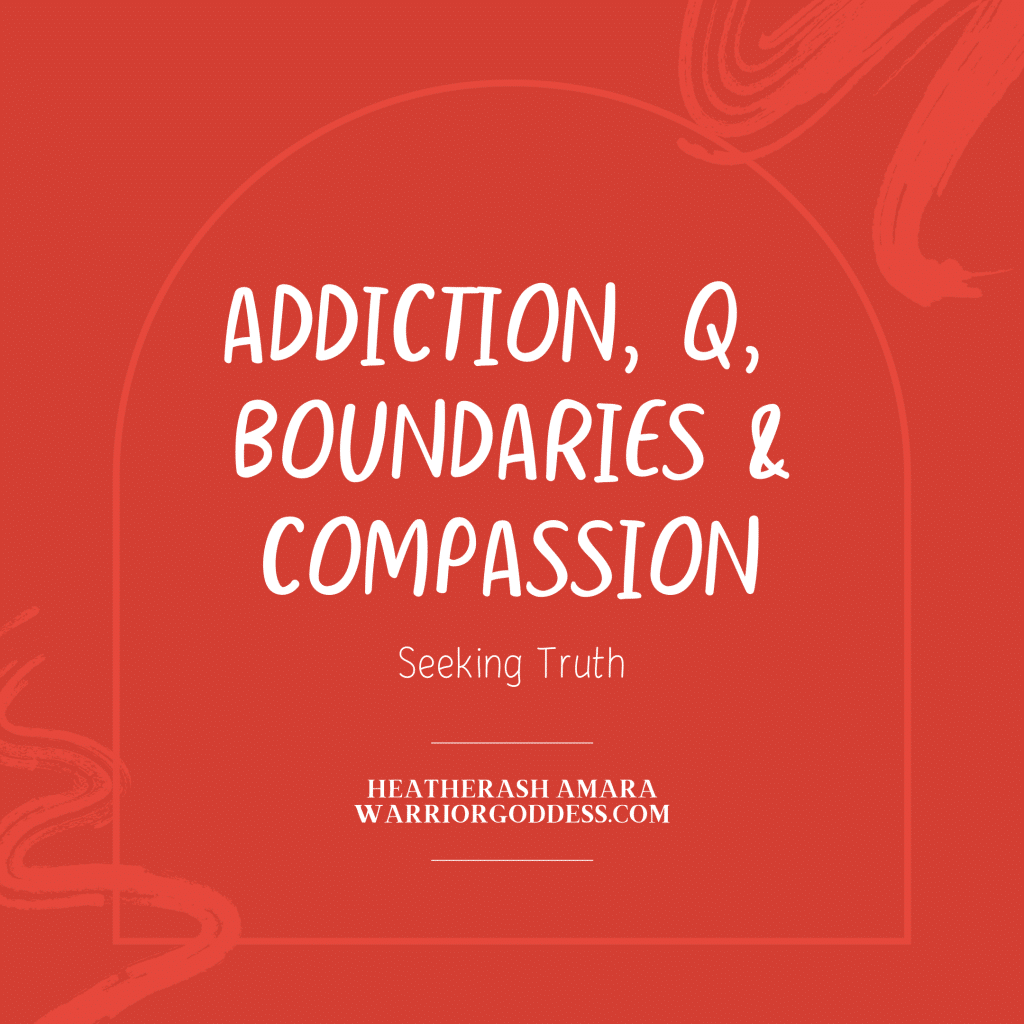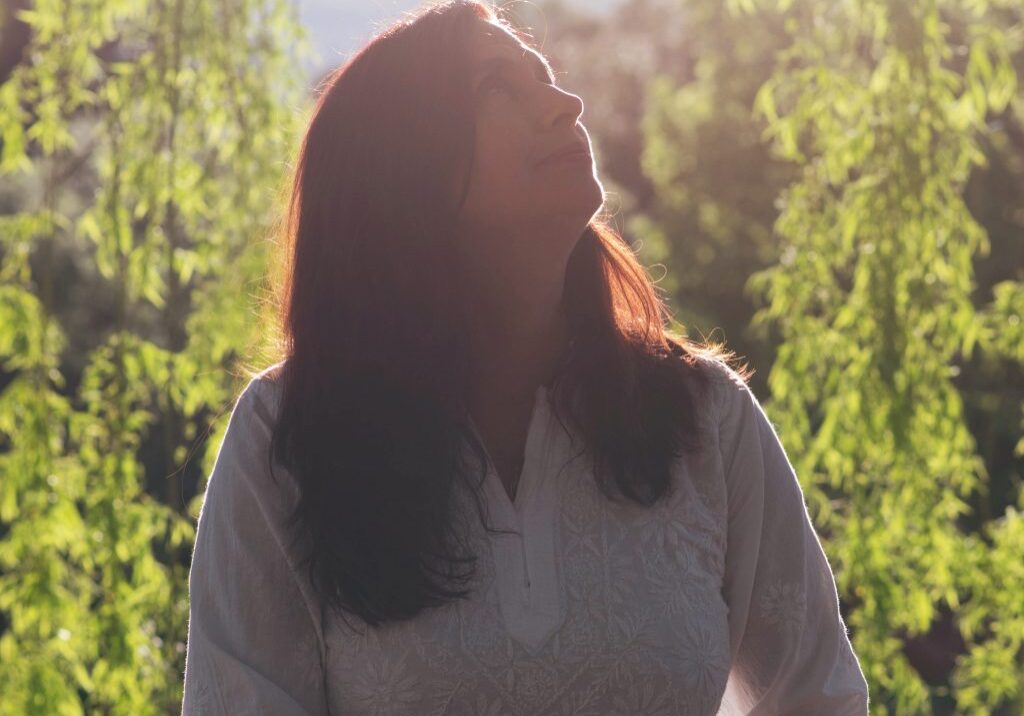Addiction, Q, Boundaries, and Compassion – Seeking Truth
Reading Time: 8 minutes
HeatherAsh Amara

What do you do when someone’s faith is invested in something you perceive as harmful to them or others?
Take Chris, for instance. Chris was part of our community in Austin, a bright 30-year-old who was a joy to be around. Except when he was high or experiencing a psychotic episode.
You see, Chris was addicted to heroin and diagnosed with schizophrenia, with a tendency to stop taking the medications that helped stabilize him.
Chris had been in and out of rehab and was stable for about a year or two when I knew him. When he started slipping back into his addiction our community rallied around him with support, mentoring, love, and financial help. But we couldn’t reach him. Chris continued to fall back into using illegal drugs and failing to take his medications.
To this day, about 9 years later, Chris writes or messages me, or my team, about every six months or so. Each time I see his name I open my heart to see where he is today. And every time so far, I write a very neutral response or make the choice to not write back at all.
Would I enter into dialogue with Chris or anyone I’ve known who has been an addict and/or struggled with mental illness? Absolutely! But not if the conversation starts with “You must contact your husband and Miguel and all of the Austin Toltecs and send me 2 million dollars immediately…” I know at that point I wouldn’t be talking to Chris; I would be talking to either the heroin or schizophrenia.
To be unconditional with another human means respecting the being that they are, and respecting their choices, even when you don’t like / agree / condone those choices (and also understanding that sometimes choice — our own and others — get compromised by many different factors.)
And also understanding that unconditional love still sets limits, boundaries, and lines in the sand; not as a way to divide but as a way to make space.
In this time of intense political, social, and emotional division we can easily create more separation, judgment, and frustration. We can ignore the things that are hard to look at, or try to simplify people’s actions into black or white, good or bad, spiritual or non-spiritual .
Or we can learn to build our compassion, empathy, presence, and boundaries.
Two of the oldest forms of addiction are being right and making others wrong. There is sense of both safety and strength in having an enemy and being on the “good” or “right” side. We each are addicted to wanting to be right at some level. The simplicity of being right and making others wrong, or having the good guys versus the bad guys scenario is much easier than navigating an increasingly complicated and confusing world.
So often we make boundaries out of making others wrong, or creating a sense of smug superiority. Or we do the opposite: don’t take a stand, pretend we agree, try to make nice.
But what if we learned to really see another person and listen deeply to what they are yearning for; what the unmet needs are within them. What if we were able to remain still inside of ourselves when faced with complexity and conflict. What if we could remain honoring to the person, even if we create a boundary around their behavior or belief?
Okay, now let’s talk about another kind of challenge and how to navigate it within yourself and with your beloveds. Let’s talk about the world of QAnon and how it has infiltrated the wellness/spirituality movement; and why it is vital that we pay attention.
My first direct connection with what is now often simply called “Q” was when a colleague emailed me just before the November 2020 election. She wrote to let me know that she had gathered a group of healers who were praying for Trump’s victory. When I wrote her back that I was voting for Biden/Harris this was her response.
Hi HeatherAsh,
I was completely shocked to read that you are praying for Biden, who is possessed by dark satanic forces, and behind massive child sex trafficking and pedophilia rings. I have no words. I wish you all the very best in the coming weeks as the veils of illusions fall one by one, to be replaced finally with the ugly truth of our world.
My group of healers and I have been well-tuned for the upcoming chaos and transition from lies to truth. Sorry to read you are on the wrong side of the war.
I wanted this to be a random occurrence. Believe me, I did not want to pay attention at first. And now I’m realizing it is actually critical for me as a loving leader, and for us as a community, to pay attention. Here’s why.
With all the gifts of connection that the world wide web brings, it also has a shadow, especially in how quickly false information can be propagated. Add in a global pandemic, social unrest, financial insecurity, government and corporate mistrust (with reason!), loneliness, isolation, and a yearning to understand and belong, and you have a potent mix for a phenomenon like QAnon.
In case you haven’t heard about QAnon, here is the brief overview:
QAnon was once a fringe phenomenon — the kind most people could safely ignore. But recently it has gone mainstream. In 2020, QAnon supporters flooded social media with false information about Covid-19, the Black Lives Matter protests and the presidential election, and recruited legions of new believers to their ranks. A December poll by NPR and Ipsos found that 17 percent of Americans believed that the core falsehood of QAnon — that “a group of Satan-worshiping elites who run a child sex ring are trying to control our politics and media” — was true. ~ From a New York Times article: What is QAnon?
Now, many of the threads that make up QAnon beliefs have roots in reality. But those initial threads of truth have been woven into a kind of eyes-wide-open blindfold that leads people to believe they are seeking and finding the answers hidden behind the curtain when they are being led on a rabbit chase facilitated by algorithms, dopamine hits, and a sense of need of being able to finally explain why things are the way they are.
Most likely you have a friend, or you yourself, have been pulled into the Q world. It is compelling, addictive, and gamified (see articles below).
Like all addictions, the pull can be so strong that it completely destroys your friendships, family, and connection to reality. Researchers are now seeing that QAnon / modern conspiracy theorists are being indoctrinated just like they are in a cult with a charismatic leader. Except there is no visible leader. But there is a potent combo of community, clues, and a cause.
Once they are engaged, it is nearly impossible to share facts or “argue” with someone about seeing beyond the Q worldview, as outrageous as the information can be. You are then labeled as a “sheeple” or told to “go do the research yourself.”
A better way to approach someone involved in Q, or with an addiction or who has wrapped the blanket of a cult around themselves, is through curiosity and empathy. Instead of trying to convince them they are wrong, explore where you have common ground. Ask questions. See if there is an opening for dialogue. Proceed slowly. And make conscious boundaries as needed. I never wrote back to my “Biden is possessed by dark forces” colleague, because as I felt into it there was no room for dialogue.
With other friends who are exploring the edges (or the deep) world of conspiracy theories, I have open dialogues, curiosity, and a safe heart space.
I believe that the way through these times is not by creating more divisiveness by shutting down dialogue or by ignoring the damaging allure of something like QAnon and believing it has nothing to do with us. It’s also not about shaming, blaming, guilting, or demonizing others. We have a rift in our society that is rooted in much deeper issues. QAnon is simply a symptom of this. And part of what will help bring healing is radical, unconditional, boundaried, open-hearted, brave love anchored in holding the complexity and heartbreak of these times.
Below I’ve shared some links to articles, broken into four sections: Overview, Communication, Recovery, and Insights/More Resources.
May we all continue to create and be safe havens for healing, connection, and navigating complexity.
Gratitude to my friend Matthew Stillman for his encouragement and resources to help me face and unpack the world of QAnon.
Here is an official statement on QAnon from Yogi Tree Center for Growth which I agree with wholeheartedly for our Warrior Goddess community:
https://www.facebook.com/TheYogiTreeCenterForGrowth/photos/a.491032144327554/3535574759873262
Overview
- The Psychological Needs That QAnon Feeds
- The Birth of QuaMom
- ‘I Miss My Mom’: Children Of QAnon Believers Are Desperately Trying To Deradicalize Their Own Parents
Communication
- Don’t go down the rabbit hole; Why critical thinking, as we’re taught to do it, isn’t helping in the fight against misinformation
- 7 ways to talk to QAnon with obsessed loved ones according to a former white nationalist
- 4 keys to help someone climb out of the QAnon rabbit hole
Recovery
- Former QAnon Followers Explain What Drew Them In — And Got Them Out
- Moving on from QAnon? Experts say these tips could help
- Checked by reality, some QAnon supporters seek a way out
More insights / resources
- Conspirituality Podcast
- A Game Designer’s Analysis Of QAnon
- QAnon: the Italian artists who may have inspired America’s most dangerous conspiracy theory
–
From: How Far Down the QAnon Rabbit Hole Did Your Loved One Fall?
Conspiracy theory researcher Dr. Bradley Franks and his colleagues have proposed just such a spectrum model, with 5 “types” or stages of conspiracy theory belief. Their model goes something like this:
Type/stage 1: People feel like “something isn’t right,” but keep an open mind as they seek answers to questions.
Type/stage 2: People feel as if “there’s more to reality than meets the eye,” are skeptical about official explanations, and start to seek out alternative sources of information.
Type/stage 3: Mistrust of authoritative sources of information increases to the point of definitive belief that some official narratives are untrue. As a result, people continue to seek information and engage with like-minded people from whom they gain a sense of belonging and group membership. They’re also more likely to get involved in “political action.”
Type/stage 4: At this point, nearly all official and mainstream accounts are rejected so that people turn away from the mainstream in favor of affiliation with an “enlightened” community of conspiracy theory believers. Non-believers are dismissed as “sheep” who are “asleep.”
Type/stage 5: In the final stage, authoritative and mainstream accounts are rejected to such an extent as to embrace belief in not only improbable, but frankly supernatural explanations for events (e.g. aliens, lizard people, etc.). At this stage, conspiracy theories and delusions may begin to overlap with self-referential aspects.
Reference the above stages of conspiracy model with don Miguel Ruiz Jr.’s book The Five Levels of Attachment; there are many ways that ALL of us get stuck in different stages of attachment and identification around everything from relationships to our beliefs to sports teams. At Levels 1 and 2 we have little attachment and are open and curious; while at Level 4 attachment (Internalization) our very identity and sense of well being is connected to something outside of ourselves; at Level 5 (Fanaticism) we will even kill to protect our beliefs.



